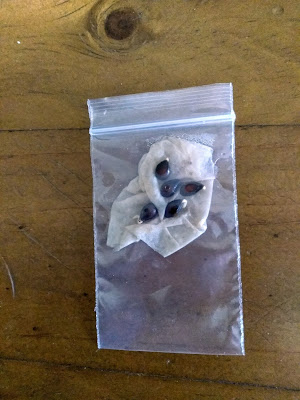I grow a lot of different varieties of tomatoes. Some are very old heirloom tomato varieties, while others I am developing myself.
 |
| Some of the tomatoes I grew |
Some of my favourite tasting tomato varieties are old Russian heirloom varieties. As a generalisation, Russian tomatoes have been bred for rich tastes and high productivity. There are very few heirloom tomatoes in Australia that can rival the flavour of the old Russian varieties.
I always used to be under the impression that Russian varieties would be quick to ripen and not mind the cold (unless there is frost) and perform well with short days with only weak sunlight. From what I understand now, that is not always the case as many Russian tomato varieties were developed for greenhouse culture. That is ok as they make up for any short comings in having a deep and often complex tomato taste that is hard to beat.
Unfortunately I have not grown very many heirloom Russian tomato varieties. I would like to grow a few more of them as their taste is often superb. Some of the Russian tomatoes I have grown are listed below.
 |
| I like tomato season |
Japanese Black Trifele - Yaponskiy Trufel Chernyyi Японский трюфель
 |
| Tomato - Japanese Black Trifele |
Japanese Black Trifele is a great Russian heirloom tomato and one of the few varieties that I will grow each and every year. They produce mahogany brown, pear shaped fruit, that is often green on the shoulders. The size and shape of the fruits varies a little even on the same truss. Apparently it was named 'Japanese' to make it sound more exotic, but was developed in Russia and it is a commercially produced tomato in Russia. These produce a large yield for me every year under different conditions, and they taste incredible. They are great raw or cooked. This plant has potato leaf and is indeterminate.
Malakhitovaya Shkatulka - Malachite Box - Малахитовая Шкатулка
 |
| Tomato - Malakhitovaya Shkatulka |
 |
| Tomato - Malakhitovaya Shkatulka |
Malakhitovaya Shkatulka is another great Russian tomato. The size and shape of the fruit lend it to slicing for sandwiches, and it goes well in a salad. Everyone who tastes this has loved it. It is difficult to tell when they are ripe from a distance, but you are close enough to touch them it becomes pretty simple. They tend to have small yield in my garden, I wish that it was higher yielding as they taste so great. It is often said that Russia does not produce green when ripe tomatoes, often when being sold in Russia it is listed as having yellow skin. I don't care how you describe it or what colour you want to call it, this variety tastes great.
Giant Siberian Pink - Sibirskiy Velikan Rozovyi - Сибирский Великан Розовый
 |
| Tomato - Giant Siberian Pink |
Giant Siberian Pink is a good tasting Russian tomato that produces very large, mostly round, pinkish fruits. This variety produces firm flesh, and has a decent number of seeds which makes seed saving easy. This plant produced a medium to large yield (medium number of fruit, super large sized fruit) over the season. Being a large fruited tomato it does not ripen early in my garden.
Little Oak Like - malenʹkiy dub, kak маленький дуб, как
 |
| Tomato - Little Oak Like |
Little Oak Like is a great tasting heirloom Russian tomato that is far too rare. It is only a small plant, maybe a foot tall and wide. The red round tomatoes have green shoulders and taste great. Little Oak Like tomatoes have the deep, rich, old fashioned tomato taste that people think of when they think of home grown tomatoes. This is one of the best tasting red tomatoes I have eaten. This plant has a large yield over a reasonably long season for a short determinate tomato. It is usually among the first tomatoes to ripen in my garden. The fruit are a little small, but more than make up for that by tasting great.
Black Russian - Chernyy Russkiy - черный русский
 |
| Tomato - Black Russian |
 |
| Tomato - Black Russian |
Black Russian is probably the most famous variety of heirloom tomato in Australia even though it is one of the worst. Black Russian tomato is by far the worst Russian tomato I have ever grown! Crops are small, the fruit cracks often, and it lack any real depth of flavour that you expect from home grown tomatoes. If you disagree with this I dare say you are either comparing it to the ethylene ripened cold stored garbage from the shops, or with other home grown insipid varieties such as 'Roma'. Let's face it, a home grown Roma will always taste bland compared to a home grown flavoursome variety. The colour of the black Russian tomato fruit is amazing inside and out, and they are a good size, unfortunately the taste, yield, and time it takes to mature always let it down severely in my garden.
 |
Various tomatoes I grow
|
I often sell seeds saved from my open pollinated organically grown plants through my for sale page. If you are interested please have a look.
If you are Russian or have a Slavic background, and know about some other traditional vegetable varieties I would love to hear from you. I would be interested to grow some more Russian vegetable varieties, not just tomatoes but other vegetables as well. I would love to grow an old Russian beetroot variety but seem unable to find the names of any.
If you grow some other Russian tomato or other Russian vegetable varieties and would like to swap some seeds or sell me some seeds please also let me know. Either leave a comment on this blog post or my email address can be found on my for sale page.
























































